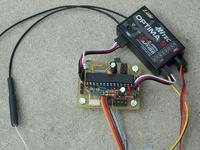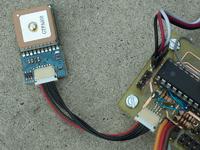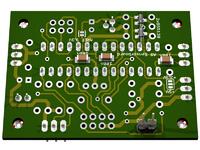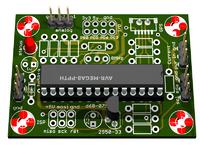| View Poll Results: Are you interested in a DIY sensorstation (and beyound) | |||
| No, I dont use telemetry. |
|
4 | 2.26% |
| Yes !!! |
|
110 | 62.15% |
| Yes, but your (estimated) pricetag of $50 is to much. |
|
18 | 10.17% |
| Maybe, I will keep an eye on this thread. |
|
45 | 25.42% |
| Voters: 177. You may not vote on this poll | |||
| Thread Tools |
|
|
|
|
Thread OP
|
Discussion
Hitec Aurora 9 DIY kit Telemetry sensorstation
Announcement. I have designed a custom sensor station for the Aurora 9 2.4 GHz system. It replaces Hitec's nitro and blue sensor station completely. My proto is working so great that i will release a (approx $50) DIY kit (all parts + PCB) to build your own sensor station. The software and hardware will be completely open source hoping that this product grows beyond my initial idea.
Prelimary specs:
Planning & status: first batch of PCB is ready in 25 working days (hopefully). Now i'm working on the supporting website with all kinds op 'application ideas'. Initial i will release 50 DIY kits. As a teaser some pics of my proto, the final board and A9 screens. Please throw in any suggestion. You can contact me here or @ dkroeske at d68 dot nl Regards, Diederich ImagesView all Images in thread
|
|
|
Last edited by d68; Jul 20, 2011 at 02:31 PM.
|
|
|
|
|
|
|
|
Regarding altitude, is there the possibility to use the power-up position's altitude as the zero value and add/subtract the offset from actual GPS value based on that initial value for a relative altitude?
Or does the A9 calculate the altitude from the GPS data itself? Nice effort, BTW! |
|
|
|
|
|
||
|
Thread OP
|
Quote:
You can display whatever you want except negative numbers. I think the best is to display relative altitudes (related to powerup value) so we now how high our plane is. Btw: GPS is not the best for altitude reading, using a Barometric pressure sensor is more accurate. But hey, easy to interface. |
|
|
|
||
|
|
||
|
Thread OP
|
Quote:
I ship from the Netherlands ( see the gps screen  ) I'm not a company, this is hobby only. Price is based on initial batch of low volume (50 pieces)). ) I'm not a company, this is hobby only. Price is based on initial batch of low volume (50 pieces)).
|
|
|
|
||
|
|
||
|
|
Quote:
Suggestion for the Glider flyers...... Or others with thin fuselages See if the board can be made more narrow. Longer but thinner is better to fit in a Glider or hotliner fuse. At 1.5 wide it is too wide to fit right now. Radian www.phflyers.com |
|
|
|
||
|
|
||
|
|
Quote:
Depending on how the altitude is calculated/displayed on the A9, since you are already using I2C (for the sensor station), you might want to look into modifying the current firmware to allow using the altitude microsensor's altitude data. 
|
|
|
|
||
|
|
||
|
Thread OP
|
Quote:
I will publish source code as soon as i verified it on the final PCB. |
|
|
|
||
|
|
|
|
|
NMEA GPS altitude data is absolute above sea level. It's not incredibly accurate though.
Funny, I just went through this same process - but backwards, to allow the Hitec sensor station to work with our receivers through an interface. I guess yours would work as well. |
|
|
||
|
|
I have tested this, use relative, when the alt come from the first gps that is the "0" alt. There is also a reset on the transmitter screen. see my post here
https://www.rcgroups.com/forums/show...&postcount=418 note if alt is below set alt the transmitter displays 0 no neg numbers. Burt Quote:
|
|
|
|
||
|
|
||
|
|
sounds like we have been working on the same thing. I never plan on selling anything, but have a sensor station made on top of a ardunio.
I have 4 analog ports, two for temp, one voltage, one current. Serial input for NMEA gps, one digital for RPM. got more then 50 invested right now, but have a reserve waitting for Hitec to release the blue station. Count me in for at least one kit, depending on shipping cost. Burt Quote:
|
|
|
|
||
|
|
||
|
Thread OP
|
Quote:
Btw. if we create a firmware pool, firmware updating is much easier than programming an beeping ESC. |
|
|
|
||
«
Previous Thread
|
Next Thread
»
| Thread Tools | |
| Similar Threads | |||||
| Category | Thread | Thread Starter | Forum | Replies | Last Post |
| Sold | HTS-Navi telemetry New For the Aurora-9 | tom6696950 | Aircraft - General - Radio Equipment (FS/W) | 2 | Jul 15, 2011 07:40 AM |
| Discussion | Aurora 9 Telemetry | hucker | Radios | 3 | Jun 25, 2011 06:41 PM |
| Question | Aurora 9 Telemetry - Field Results? | ShoGinn | Radios | 14 | Mar 16, 2011 03:31 AM |
| Sold | Hitec Aurora 9 TX&RX +HPP-22 + Telemetry Pack sold | joe1l | Aircraft - General - Radio Equipment (FS/W) | 2 | Mar 07, 2011 05:09 AM |
| Discussion | Aurora 9 - Telemetry Reading for Individual LIPO Cells | WEREE | Hitec/Multiplex USA | 3 | Jun 03, 2010 06:25 PM |







